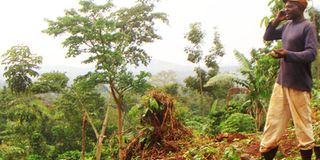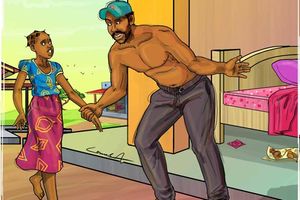Prime
Inside Mabira: voices from the forest

The Chairman LCII Buwoola parish Moses Luyombya in one of his gardens in Bakata village.
What you need to know:
Most people may think Mabira is all tree and plants but there are whole communities living in the middle of the forest with schools to boot.
Musoke Katamba has walked every inch of Mabira forest. He grew up, went to primary school and married here. His grandfather was also buried in the village located in the heart of the rain forest. Mabira has been Katamba’s childhood home from where he played games, ate wild fruits in the forest, and breathed its cool air. Occasionally, he admits to cutting a tree or two for firewood, or to make a living.
I met Katamba after I had fruitlessly tried to get in touch with the forest reserve officials at their office in Nkaaga. I was shocked to find a village which also has a trading centre surrounded by a thick forest. The forest reserve official was not at his office as he was reportedly on duty in the forest. His name I was told is Kadiri Bagampadde. The telephone number I was given has not gone through for a week since I left the station. He could be that busy.
A rumour that Mehta, the sugar mogul had started cutting down the forest took me adventuring into the formerly 8sq mile forest. Formerly, because more than three square miles are no more, due to human activity like cultivation, timber, firewood cutting and human settlement. “When you reach Buwoola, get a boda boda to Sanga. Mehta has started cutting trees to grow sugarcane,” a supposed whistleblower whose information turned out to suspect, told me.
Residents to blame for encroachment
Buwoola is a little stage with a shelter that is made of old ironsheets, 4km inside Mabira from Jinja. The stage where youthful boda boda cyclists spend their days discussing football results and staring at women passing by, does not tell you much of what awaits you inside.
But, the young man who rides me to Sanga and speaks a mixture of Lusoga and broken Luganda, does not shy away from telling me, “Mehta does not grow sugarcane here, but, the residents are the ones cutting down the forest.” He tells me people who play hide and seek with forest officers, cut trees for charcoal burning or timber, but, says, the untouchable beneficiaries are people who claim to be security officers. “These people even scare forestry officers,” he says.
In any case, he rides me past permanent homes only a kilometre into the forest. Some homes look over half a century old. The rat paths do not stop him from riding past big stones in the middle of the bushy trails.
“This is a forest reserve,” he tells me as we enter a section of the forest, before we briefly enter a sugarcane plantation, atop the hill.
“Isn’t this Mehta’s sugarcane?” I ask, thinking I have at last hit the gold mine. From the sugar plantation I can see past the forest in the valley and then, Mehta’s tea estate in Lugalambo. He says it is for individual farmers who are Mehta’s outgrowers.
“There are landmarks that separate private people’s land and the forest,” he tells me, as we go past a farm with Friesian cattle. Sanga is one of the villages that make Buwoola, a three village local council. The other villages are Nkaaga where the forest reserve office is located, and Bakata.
When I meet the chairman of the village, Mr Paulo Mubiru, I realise he is a man with measured words. The moment I introduce myself as a journalist, he gives me his time although he is on his way to a meeting. He assures me that Mehta has not tampered with any part of the forest so far. But he also says his people are not happy that the government wants to give away part of their cherished treasure. “The government once sent us out of this forest. We left it in the interest of nature,” he narrates. “But we are equally disturbed with the reports that they want to give the forest to a foreigner.”
Mr Mubiru is quick to suggest though, if the forest is not important, it is better it is given to the indigenous people because their land in Buwoola has ceased to be productive. “But, this forest is our livelihood – its rains and medicines are part and parcel of our life,” he adds as we ride down to Nkaaga at a primary school where he was having a meeting with school officials. Yes, there is a school in the forest. In fact, two primary schools, each with over 300 children.
Mr Mubiru says that his village alone has more than 1,000 people. In the last elections, he says, there were about 150 voters. Buwoola is a village on a hill. It sits on about one and half square miles. Mr Katamba is more exact. “It is 900 acres,” he says.
Katamba’s grandfather owned most of this village. The old man also inculcated into his children the usefulness of the forest. “We shall fight hard to ensure no one cuts down this forest,” he tells me. His grandfather, who died in 2007 when he was over 90 years left him a valuable piece of advice – “Mabira is our life. It is a source of our livelihood,” Katamba recalling the old man saying.
Some years ago when a conflict over Mabira giveaway that also cost a life of an Asian in Kampala occured, Katamba recalls his frail grandfather walking a mile to the main Jinja-Kampala highway at Buwoola stage in protest. That was a big statement, according to him. “We are people of the forest. We are born in the forest. And we shall be buried here,” he recalls the old man telling residents who asked him to stay back home.
Now his grandson who remembers how passionate the old man was about the forest says, “When everyone else is crying over rain, for us in Buwoola, we are planting or harvesting.” That is the beauty of living in a natural forest – rain is guaranteed. On these 900 acres is a village of cultivators. They grow bananas, coffee, cassava, potatoes and yams. They also rear animals like cattle, goats, pigs and sheep among others.
Though coffee is fast catching the wild disease, they sell other produce to neighbouring townships, including, Najjembe, a roadside market in the heart of the forest, that is famous for its roasted chicken and bananas (gonja).Moses Luyombya, the chairman LC2 of Buwoola Parish says, “We are a privileged lot here in Buwoola. We are farmers who depend on rain fed agriculture. But here we get rains anytime, thanks to this forest.
Cutting down this forest could change the course of lifestyle and nature at large. It would reduce the water tables, and if we are serious about electricity generation, how do we cut off the feeder of River Nile and L. Victoria? We would be contradicting ourselves.However, Katamba also tells me, Mabira forest’s worst enemies are people who cut timber. “People come here saying they are soldiers. They take the timber,” he said, admitting, that most locals ferry firewood to the market places.
Faulting the government
He also tells me that the piece of land President Museveni sent away people from in Namavundu towards Kayunga, is now bushy, and he faults the government on why they did not plant trees in that piece of land (Mr Luyombya says, those people were sent away from Namavundu, a part of Mabira they had encroached upon, in 1988). “That land could be forest again by now. Museveni sent people away around three or four years after coming to power. It is about 20 years now and natural trees like Musizi could be quite big,” Katamba says. What Katamba did not know is that the encroachment on the forest by settlers is a problem in itself.
Mabira needs not only liberation from being given away, but, also from indigenous encroachers who have descended on the forest for decades, each passing day, raiding its trees for charcoal burning, timber, firewood and above all, cultivation and human settlement.




